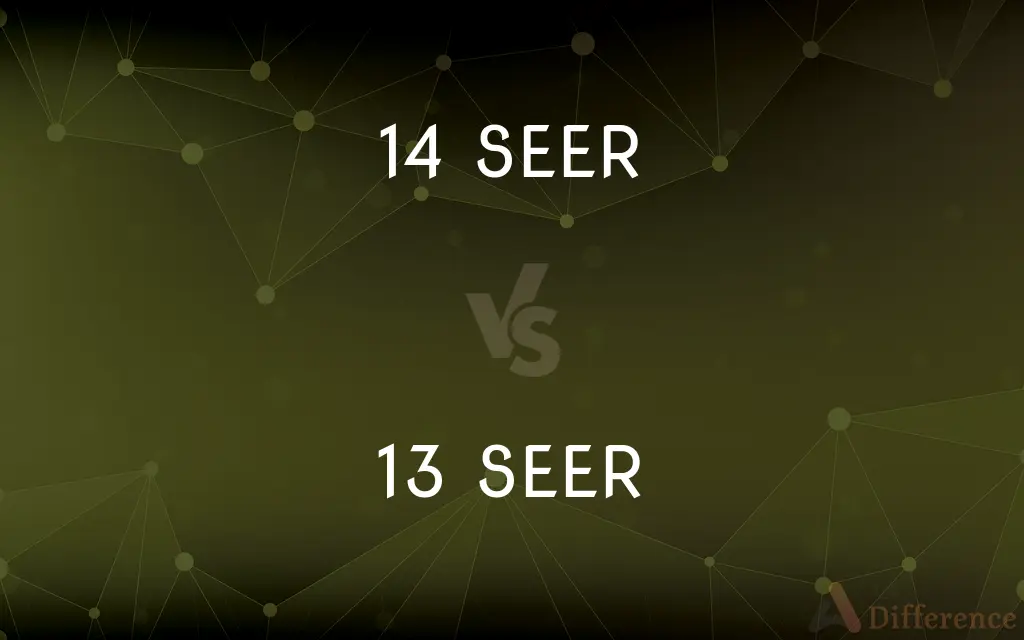14 SEER vs. 13 SEER — What's the Difference?
By Tayyaba Rehman — Published on January 28, 2024
14 SEER and 13 SEER refer to Seasonal Energy Efficiency Ratios, with 14 SEER being more energy-efficient than 13 SEER, resulting in lower energy consumption and costs.

Difference Between 14 SEER and 13 SEER
Table of Contents
ADVERTISEMENT
Key Differences
The Seasonal Energy Efficiency Ratio (SEER) is a measure of the cooling efficiency of air conditioners and heat pumps. A 14 SEER unit has a higher efficiency rating than a 13 SEER unit. This means that a 14 SEER system consumes less energy to provide the same amount of cooling as a 13 SEER system, making it more environmentally friendly and cost-effective in the long run.
The difference between 14 SEER and 13 SEER may seem small numerically, but it can result in significant differences in energy usage and cost savings. Generally, each point increase in SEER rating translates to about 5-7% more efficiency. Therefore, a 14 SEER unit is approximately 5-7% more efficient than a 13 SEER unit, which can lead to noticeable savings in energy bills over time.
The choice between a 14 SEER and a 13 SEER unit often depends on individual needs, budget, and climate. While a 14 SEER unit may have a higher upfront cost, it can offer lower operating costs. In contrast, a 13 SEER unit might be more budget-friendly initially but could result in higher energy bills.
In some regions, there are minimum SEER requirements set by local or federal regulations. These regulations might mandate a minimum of 14 SEER in new installations, especially in areas where air conditioning usage is high, making 13 SEER units non-compliant in those areas.
It's also important to consider that SEER ratings are a maximum efficiency under ideal conditions. The actual efficiency of an air conditioning unit depends on factors like proper installation, maintenance, local climate, and home insulation.
ADVERTISEMENT
Comparison Chart
Energy Efficiency
Higher efficiency (around 5-7% more than 13 SEER)
Lower efficiency compared to 14 SEER
Energy Consumption
Lower energy consumption
Higher energy consumption
Cost Savings
Greater long-term savings on energy bills
Lower upfront cost but higher operating cost
Environmental Impact
More environmentally friendly
Less efficient, higher environmental impact
Regulatory Compliance
Meets higher regulatory requirements in many areas
May not meet certain regional efficiency standards
Compare with Definitions
14 SEER
Results in lower energy consumption.
Our 14 SEER air conditioner has reduced our electricity bills.
13 SEER
Consumes more energy than 14 SEER models.
Our 13 SEER AC is less efficient, leading to higher bills.
14 SEER
A higher efficiency air conditioner rating.
I chose a 14 SEER unit for its energy savings.
13 SEER
May not meet certain regional efficiency standards.
We couldn't install a 13 SEER unit due to local regulations.
14 SEER
Provides long-term cost savings.
Investing in a 14 SEER AC will save us money over time.
13 SEER
Less environmentally friendly than 14 SEER.
We're considering upgrading from 13 SEER for environmental reasons.
14 SEER
May have a higher initial cost.
The 14 SEER model was more expensive upfront, but worth it.
13 SEER
A lower efficiency air conditioner rating.
We installed a 13 SEER unit due to budget constraints.
14 SEER
Complies with stricter energy standards.
Our state requires a minimum of 14 SEER for new installations.
13 SEER
Lower initial cost but higher operating expenses.
The 13 SEER air conditioner was cheaper but costs more to run.
Common Curiosities
Is a 14 SEER unit more energy-efficient than a 13 SEER?
Yes, it's about 5-7% more efficient.
Is the upfront cost of a 14 SEER higher than a 13 SEER?
Generally, yes, due to higher efficiency technology.
Can I install a 13 SEER unit anywhere in the US?
It depends on local regulations; some areas require a minimum of 14 SEER.
How significant is the efficiency difference between 14 SEER and 13 SEER?
It's notable, especially in areas with high AC usage.
Is a 13 SEER unit a bad choice?
Not necessarily, it can be budget-friendly and suitable for some climates.
Are there environmental benefits to choosing a 14 SEER unit?
Yes, due to lower energy consumption and emissions.
What does SEER stand for?
Seasonal Energy Efficiency Ratio.
Will a 14 SEER unit always result in lower bills?
Typically, yes, but actual savings depend on usage and climate.
Are both 14 SEER and 13 SEER units available in the market?
Yes, but availability may vary due to regional regulations.
Will I save money with a 14 SEER compared to a 13 SEER?
Yes, in the long run, due to lower energy bills.
Do SEER ratings affect the cooling capacity?
SEER ratings measure efficiency, not cooling capacity.
Do both 14 SEER and 13 SEER units require professional installation?
Yes, professional installation is recommended for both.
Is maintenance different for 14 SEER and 13 SEER units?
Maintenance is generally similar, but always follow manufacturer guidelines.
Should I choose a 14 SEER unit for a hot climate?
It's a good choice for efficiency and cost savings in hot climates.
Can I upgrade from a 13 SEER to a 14 SEER unit?
Yes, but consider the cost and potential energy savings.
Share Your Discovery

Previous Comparison
XML vs. XHTML
Next Comparison
Bridges vs. ViaductsAuthor Spotlight
Written by
Tayyaba RehmanTayyaba Rehman is a distinguished writer, currently serving as a primary contributor to askdifference.com. As a researcher in semantics and etymology, Tayyaba's passion for the complexity of languages and their distinctions has found a perfect home on the platform. Tayyaba delves into the intricacies of language, distinguishing between commonly confused words and phrases, thereby providing clarity for readers worldwide.
















































